Consider Adding More Spinach to Your Diet!
By Heide Kennedy, Arizona Farm Bureau Communications Intern
Eating spinach in large quantities always makes me think of the old cartoon my brothers and I used to watch, Popeye the Sailor. Every time that Popeye was in a sketchy situation, he would whip out a can of spinach, eat the whole thing, and then become incredibly strong and effortlessly defeat all of his opponents.

While we thought that this was so cool when we were younger, it was never enough incentive to make us actually enjoy eating spinach. But, Popeye did have a good reason for choosing spinach as his snack of choice, as it is packed full of vitamins, minerals, and fiber!
Spinach is a great leafy green to incorporate into our diets. Not only is it super versatile in terms of what it pairs well with, but it provides a nutritious punch all while being low in calories. According to registered dietician Marissa Meshulam, spinach is a great source of fiber, folate, potassium, magnesium, vitamins C and K, lutein, beta carotene, and zeaxanthin. These nutrients play a big role in some of our body’s main functions and can help to:
- Reduce inflammation.
- Lower blood pressure.
- Protect eye health.
- Promote red blood cell health.
- Protect brain health.
- Promote gut health and bowel regularity.
When comes to adding more spinach into your diet, registered dietician Trista Best says that the best way to consume spinach is by cooking it down with some water. This makes the nutrients more easily absorbed by the body.
Did you know that Arizona agriculture produces spinach? From October to April spinach is produced right here in our home state! This is great news for consumers, because getting fresh, locally grown spinach to add to your salads and other meals is easier than ever! Make sure to look for locally grown spinach and other produce next time you’re out at the grocery store or farmer’s market!
For more health-related articles, or articles on food in general, check out the Fill Your Plate blog!
Choose Your Cereal Wisely!
By Heide Kennedy, Arizona Farm Bureau Communications Intern
When my brothers and I were growing up, our favorite thing to have for breakfast each morning was a bowl of cereal. As you can probably imagine, our cereal of choice was definitely not Raisin Bran or Grape Nuts. Our go-to cereals were usually Coco Puffs, Lucky Charms, or Cinnamon Toast Crunch, which taste great but are definitely not the best when it comes to nutrition due to their high sugar and carbohydrate content. Here are a few tips on how to make the best choices when it comes to selecting breakfast cereals. 
Look for whole grains.
When picking a cereal, it is important to pick one that is made from whole grains, as whole grains provide you with a great deal of fiber. According to registered dietician Paula Doebrich, fiber is an essential nutrient and most of us aren’t getting enough of it on a daily basis. She says that breakfast cereal is a great way to incorporate more of it into our diets.
Avoid added sugars.
Most breakfast cereals are chock full of added sugars, especially the fun, fruity, kids cereals. While they may be tasty, they are not very healthy for you. So, it is best to look for the cereals that don’t have extra sugar in them. If you still want a bit of sweetness in your bowl, try adding some fruit on top for a little bit of sweetness and extra nutrients.
Pair it with protein.
Cereal is always best with milk, which is a great source of protein. Pairing cereal with a protein helps you to feel fuller for a longer period of time. Doebrich notes that it is wise to pay attention to the amount of protein in the milk that you choose. Plant based milks don’t often have as much protein in a serving as regular milk does.
With that being said, choose your cereals wisely to make sure that your morning starts off great with a nutritious breakfast! Opt for whole grains, low sugar, and add some protein to keep you full and fueled for the rest of your day!
For more health-related articles, check out the Fill Your Plate blog!
Move Over, Olive Oil! Whole Olives are Just as Nutritious!
By Heide Kennedy, Arizona Farm Bureau Communications Intern
We all know that olive oil is touted as being the healthiest oil option out there, and it’s true! But, whole olives are just as healthy! 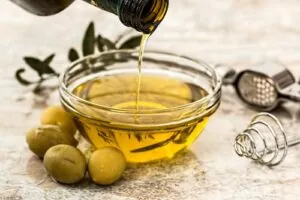
What’s not to love about whole olives? They’re salty and savory, and go great with a wide variety of foods. When I was a kid, I loved just rating black olives by themselves. And, as many olive-loving kids know, the best way to eat them is by sticking your fingers into the little holes and biting them off from there! Besides being fun and delicious to eat, olives pack a huge nutritional punch and are a great way to add some extra nutrition to your meals.
Small as they might be, olives have a lot of nutritional value to them. According to registered dietician Adda Bjarnadottir, olives are a great source of the following:
- Monounsaturated fat (a healthy fat, don’t worry!)
- Oleic acid
- Fiber
- Vitamin E
- Iron
- Copper
- Calcium
- Antioxidants including oleuropien, hydroxytyrosol, tyrosol, oleanolic acid, and quercetin
Thanks to all of these vitamins, nutrients, and antioxidants that olives provide, eating them in our meals can actually provide us with many different health benefits. Registered dietician Devon Peart notes that there are lots of ways that eating olives can benefit our health. Whether it be reducing inflammation and swelling, keeping our hearts healthy, managing blood sugar levels, or simply just adding some extra vitamins and minerals to our diets, you can’t go wrong with olives!
So, grab a can of olives, make some tapenade to spread on some bread or crackers, slice some on top of a salad, or just eat them plain and enjoy their delicious taste and all of the nutrition that they have to offer!
For more health-related articles, check out the Fill Your Plate blog!
Eat Your Fruits
By Heide Kennedy, Arizona Farm Bureau Communications Intern
We’ve all long known the importance of getting lots of fruits into our diets. Eating fruits regularly is a great way to increase the number of plants that we are incorporating into our diets, they are a delicious and sweet snack that is free of added sugars and are chock full of fiber and other essential nutrients. 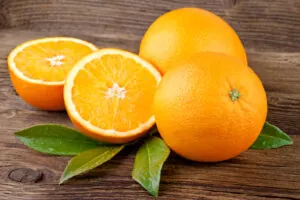
While there are so many different fruits out there, the following are ones that are recommended by dieticians, as they pack the greatest punch when it comes to nutrition! And we’ll highlight what fruits are grown in Arizona!
- Blueberries, raspberries, and blackberries – These are all a great source of fiber, and multiple vitamins, and are lower in sugar! (Arizona’s really good at growing blackberries and raspberries!)
- Apples – A great source of soluble and insoluble fiber! (We have several commercial and u-pick apple orchards in Arizona. We’re known for a naturally sweet and crisp apple with several varieties grown here.)
- Oranges – Chock full of vitamin C! (One of Arizona’s “5 C’s” is citrus and while we don’t grow as many oranges as in the past, we do still raise a wonderfully sweet and juicy orange.)
- Prunes – High in fiber and vitamin K!
- Bananas – A great source of potassium and fiber!
- Tomatoes – Full of vitamin A, and lycopene, a powerful antioxidant! (Commercially as well and small farm growers for the farmers’ markets throughout Arizona)
- Watermelon – Very hydrating due to its high-water content and potassium content! (Now this is where we shine. Our watermelon farmers know the best varieties to grow in Arizona and how to grow them crisp and sweet)
- Avocados – Full of vitamins and healthy fats! (California does this fruit best but Arizonans know how to make the best guacamole.)
If you don’t eat fruit regularly already, consider adding more of them to your diet! They are a healthy, sweet way to incorporate more vitamins, minerals, and nutrients! So, go ahead and make yourself a fruit salad, or just choose one and eat it fresh! To see what kinds of fruits are grown locally here in Arizona, check out the Fill Your Plate website!
Sprinkle Your Foods with a Little Extra Nutrition!
By Heide Kennedy, Arizona Farm Bureau Communications Intern
Often when we think of cooking healthy meals and eating healthier in general, we think of making some drastic changes to our diets, such as cutting carbs, reducing sugar or sodium intake, adding more fruits and vegetables into our diets, or whatever the case may be. While each of those is a great way to eat a healthier diet, doing so doesn’t always require such a big change. Something as small as sprinkling nutrient-filled foods on top of our regular foods can have an impact on our health. 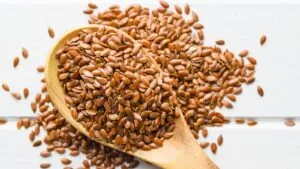
Many small, sprinkle-able foods carry loads of nutrition. Whether it be healthy fats, vitamins, minerals, fiber, or antioxidants, a little bit of some foods can go a long way! According to registered dietician Samantha Cassetty, while the amount that you sprinkle on top of your foods might not provide enough of each nutrient to meet your daily needs, it is a step towards your daily goal, and the little bit of added nutrition that you get all adds up!
Some examples of foods that you can sprinkle on top of your meals to add a little extra nutrition include:
- Cinnamon
- Hemp seeds
- Chia seeds
- Garlic
- Flaxseed
- Beetroot powder
- Red pepper flakes
- Cocoa powder
- Nutritional yeast
So, try adding a little extra “oomph” to your meals by sprinkling some more nutrients on top! When it comes to nutrition, every little bit counts!
For more health-related articles, check out the Fill Your Plate blog!
Papaya – A Nutritious Tropical Treat!
When you think of refreshing summertime snacks, what comes to mind? Often, watermelon is the go-to answer due to its cold, crisp, sweet, and high water content. Additionally, watermelon is super nutritious. Of course, we grow lots of watermelon in Arizona so you can keep this fruit as a favorite.

While it is much less popular, another fruit that is equally as hydrating and nutritious as watermelon is papaya. This bright orange fruit and its edible seeds are the perfect tropical addition to your summertime snack selection!
According to registered dietician-nutritionist Sarah Schlichter, papaya boasts a great nutritional profile. She says that papaya contains more than the recommended daily amounts of vitamins A and C and it provides a huge punch of antioxidants and fiber. Also, papaya is 88% water, so it is a very hydrating fruit. Thanks to its nutrient content, consuming papaya could offer you the following health benefits:
- Strengthened immune system
- Improved digestion
- Lower cancer risk
- Reduced inflammation
So, consider adding a tropical flair to your summer fruit bowl and reap all of the nutrition and health benefits that papaya can provide you!
For more health-related articles, check out the Fill Your Plate blog!
Nightshades – Inflammatory or Anti – Inflammatory?
By Heide Kennedy, Arizona Farm Bureau Communications Intern
Growing up, I absolutely LOVED hot sauce or anything spicy in general. Our fridge was stocked with all sorts of different hot sauces that I would put on anything except for sweet foods. In my opinion, the spicier the food, the better! But, as the years went on, I began to notice that I was incredibly sensitive to peppers. I also started to notice my body react to eating potatoes, tomatoes, and a few other foods. It turns out that I have a sensitivity to vegetables that are a part of the nightshade family. Nightshades have often been considered to be inflammatory, but then again, it is said that they have anti-inflammatory properties. So, here is a quick crash course on this family of plants! 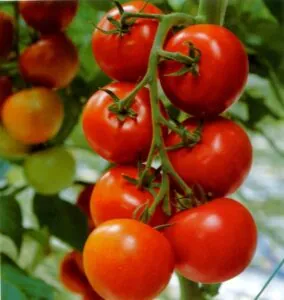
What exactly are nightshades? According to Dr. Carolyn Williams, nightshades are plants that produce a toxic compound called glycoalkaloids, which is basically a defensive compound. Common nightshades include tomatoes, white potatoes, any kind of pepper, eggplant, tomatillos, and more.
There is debate as to whether these plants cause inflammation or actually help it. The main argument in favor of them causing inflammation is that solanine, the most prevalent glycoalkaloid found in nightshades, can actually cause poisoning if too much is eaten. But according to Dr. Williams, this is very rare. In terms of nightshades actually being anti-inflammatory, Dr. Williams points to all of the antioxidants found in these plants. She also notes that they are nutritious as well due to their great vitamin C and fiber content.
But there are people such as me who do experience sensitivities to nightshades. Thus, it is speculated that nightshades don’t necessarily cause inflammation, but rather the solanine triggers pre-existing inflammation. Dr. Williams notes that those who have an auto-immune condition or irritable bowel syndrome are more likely to feel irritation after consuming nightshades.
Ultimately, it comes down to how your own body handles nightshades. If you’re like me, then you’ll probably feel better staying away from them. But, if you can eat them without any inflammation, then enjoy them and the nutrients that they bring along with them!
For more health-related articles, check out the Fill Your Plate blog!
Do You Have a Gluten Sensitivity or is it Something Else?
By Heide Kennedy, Arizona Farm Bureau Communications Intern
Food sensitivities are never fun. As a person who has many sensitivities to certain foods, I know just how hard it can be to have to completely alter your diet to accommodate those sensitivities. If you’re experiencing digestive distress, there is a chance that gluten could be the culprit, as it is an incredibly common food that some people, including myself, are sensitive to, or even allergic. Gluten is especially hard to avoid because it seems like it is sneaked into so many different foods. But, before you go making any drastic dietary changes, doctors and dietitians point out a few other health issues that might be causing that distress rather than gluten sensitivity.

According to 4 doctors and registered dieticians, while common, gluten isn’t always the cause of your problems. They offer the following alternative causes for those digestive distress symptoms that aren’t caused by gluten.
- A different food intolerance such as lactose or fructose
- Added ingredients such as added fiber, artificial sugar, or alcohol
- Bacterial overgrowth in the small intestine
- Gastroparesis
- Irritable bowel syndrome
- High-fat foods
With that, it is important to thoroughly evaluate your symptoms and potentially see your doctor to properly diagnose the cause of your digestive distress, as there is a chance that it is not gluten sensitivity.
For more health-related articles, check out the Fill Your Plate blog!
Different Nuts Provide Different Health Benefits
By Heide Kennedy, Arizona Farm Bureau Communications Intern
One of my favorite snacks to take whenever I’m on the road or just need a simple snack to pack is nuts. Not only are they satiating, but they are small, dry, not messy, and easy to just put in a little bag and stash somewhere. But not only are they a convenient snack, but they are also a super healthy snack. 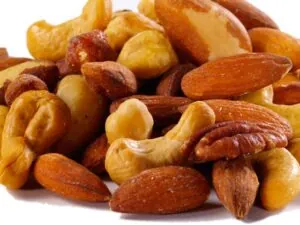
According to registered dietician Maya Feller, “Nuts are a wonderful source of plant-based proteins, heart-healthy fats, vitamins, minerals, and fiber. Each contains varying amounts of these nutrients.” Since the nutritional content of nuts varies by kind, different nuts provide different health benefits. Nutritionists say that the following nuts provide the following benefits.
- Almonds – Best for skin health due to high levels of vitamin E
- Peanuts – Best for stress relief and reduced cholesterol levels
- Cashews – Best for reducing blood pressure and reduced cholesterol
- Pistachios – Best complete plant protein source
- Walnuts – Best for brain health thanks to omega-3’s
- Pecans – Best for heart health due to antioxidant content
- Macadamia nuts – Best for lowering cholesterol
- Brazil nuts – Best for thyroid health due to selenium content
Incorporating nuts into your diet is easy! Whether you simply snack on them straight from the bag, use them in granolas, trail mixes, or baked goods, or even take it a step further and make your own nut butter or milk, there are so many ways to take advantage of all the nutrients that nuts have to offer!
For more nutty articles, check out the following from Fill Your Plate!
Serve Mustard Coleslaw at Your Summer Barbeques!
By Heide Kennedy, Arizona Farm Bureau Communications Intern
Summertime always calls for a barbeque at some point or another! Both the barbequed meat and all the side dishes that go with it are always amazing! Every couple of months, my family loves to take a day and get a fire going and smoke a ton of meat to keep stocked in the fridge and freezer. And my mom always makes a big batch of coleslaw to go with it! 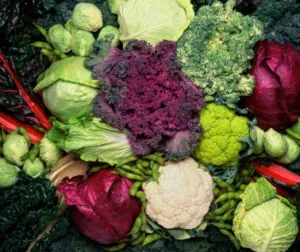
Coleslaw is the perfect summer barbeque side dish because it is cold, crisp, delicious, and pairs so well with smoked meat. Not only that, but cabbage is also incredibly nutritious!
According to clinical nutritionist Leticia Sores, cabbage is a great source of fiber, folic acid, potassium, vitamins A and C, and antioxidants. To top it all off, it is very low in calories! Thanks to its diverse nutrient content, cabbage can help to lower blood pressure, reduce inflammation, promote satiety, promote your immune system, promote vision health, and improve digestion.
So, next time that you’re barbequing this summer, make sure to include a big bowl of coleslaw on your menu!
Also, don’t worry, I wasn’t going to leave you hanging in regard to my mom’s coleslaw recipe! Check it out below!
Mustard Coleslaw
Ingredients:
- 1 Head of cabbage chopped into square pieces
- 3 large carrots grated
- ½ Cup of mayonnaise
- ½ Cup of mustard
- ¼ Cup of vinegar
- 1 tsp. Celery seeds
- Salt and pepper to taste
Combine the grated carrot and chopped cabbage in a large bowl. Mix the last five ingredients together and pour over the cabbage and carrots and toss well.
*The flavor is much better after it has sat in the fridge for a couple of hours.
*Also, my mom never really measures ingredients, so feel free to adjust according to your taste!
My favorite thing about her coleslaw recipe is that it isn’t your typical classic coleslaw that is sweet and slightly tangy. Rather, hers is a mustard slaw, so it’s super tangy!
Did you know that we grow cabbage and carrots right here in Arizona? Next time that you’re shopping for your coleslaw ingredients, keep an eye out for the produce that has been grown here in Arizona! Take a look at the Fill Your Plate website for more information on where to find locally-grown foods!
What to Look for on a Nutrition Label
By Heide Kennedy, Arizona Farm Bureau Communications Intern
When you’re at the store purchasing food to stock in your fridge, freezer, and pantry, how often do you look at the nutrition label on the back? If you don’t already, I would suggest that you do, as there is a lot of helpful information contained on that label as to the health of the food. Although it may seem like just a bunch of hard-to-pronounce words, numbers, and percentage signs, these labels ought to carry some weight when it comes to the foods that you choose to feed your family.

According to registered dietician Stephanie Grasso, carefully looking at nutrition labels is an important part of maintaining a balanced diet. Luckily, interpreting these labels is actually very simple. Grasso says that the first place to start is by looking at the number of calories in a serving of that food. Next, she says to look at the carb-to-protein ratio. Foods that are high in protein are good because they regulate blood sugar and keep you feeling satisfied longer. But, if it is a high-carb food, then she suggests making sure that it also has a lot of fiber so that it still helps to keep you full.
When it comes to nutrients, the percent daily values are a good place to look. But sometimes these can be confusing, because how much is a good amount for each of these nutrients? Grasso has the perfect tip for determining if those percentages indicate if the food is high or low in specific nutrients. If the percentage is 20% or higher, then it is a high source of that nutrient, and anything that is 5% or lower is considered low.
With that being said, next time that you are out grocery shopping, keep these tips in mind when checking nutrition labels so that you can be confident that the foods that you’re feeding your families are providing them with the right nutrition!
For more grocery shopping tips, check out these articles from Fill Your Plate!
Add Some Citrus to Your Water
By Heide Kennedy, Arizona Farm Bureau Communications Intern
We all know the importance of staying hydrated. It is especially important for those of us living here in Arizona, as the heat during the summer can get quite intense, making it even more vital that we keep replacing the water we shed while sweating.
But it can sometimes be hard to make ourselves drink as much water as we should. The Cleveland Clinic suggests adding lime or lemon juice to your glass of water to help you drink more, as well as to reap the health benefits that these citrus fruits provide. 
According to registered dietician Carly Sedlacek, lemons and limes are chock full of nutrients. These citrus fruits are a good source of the soluble fiber pectin, calcium, magnesium, potassium, and vitamins A, B, C, and D. Sedlacek also says that they are full of antioxidants and phytonutrients.
And the cool thing, we grow wonderful citrus in Arizona!
Thanks to their vast nutrient content, lemons and limes can provide you with the following health benefits.
- Improves skin
- Improves digestion
- Increases hydration
- Increases immunity
- Helps regulate blood sugar
- Supports healthy weight loss
- Improves the absorption of iron
- Potentially could reduce risk of certain cancers
Sedlacek notes that these fruits aren’t a cure-all by any means. But, adding them to your water is a simple way to get a few extra nutrients! More importantly, it can help you to drink more water because the juice adds a little bit more interest to plain old water!
Did you know that we grow citrus right here in Arizona? Look for some Arizona grown lemons and limes next time you’re shopping at your local grocery store or famer’s market!
For more health-related articles, check out the Fill Your Plate blog!
20 Dietician-Recommended Heart-Healthy Snacks
By Heide Kennedy, Arizona Farm Bureau Communications Intern
We all know the feeling when a few hours after lunch, we begin to feel “snacky” again. Often, when it comes to buying or preparing snacks, our main objectives are to find a snack that is quick, not too messy, convenient, and fairly healthy.
While these are great goals to have when snacking, another snack food criterion to also consider is how they support heart health. Believe it or not, a lot of foods that are easy snacks also have a great deal of heart health benefits.
Check out this list of 20 dietician-recommended heart-healthy snacks: 
- Almond butter and fruit
- Grapes, cranberries, or pomegranates
- Avocado toast
- Hummus and veggies
- Bread and olive oil
- Tuna, avocado, and cucumber slices
- Tuna salad
- Salmon and crackers
- Walnuts and fruit
- Bean salsa and sliced bell peppers
- Popcorn
- Roasted chickpeas
- Edamame
- Pumpkin seeds
- Cheese and whole grain crackers
- Trail mix
- Peanut butter and whole grain toast
- Overnight oats and nut butter
- Corn chips and guacamole
- Yogurt or cottage cheese
If you haven’t noticed already, there are a couple of nutrients that all of these snacks have in common. These would be fiber, healthy fats, and antioxidants, which registered dietician Erica Ingraham considers to be the trifecta of heart healthy nutrients.
But remember, these are tasty snacks so watch how much you eat. Portion control still needs to be in place.
So, the next time that you’re preparing snacks for yourself, or shopping to replenish your pantry, make sure to incorporate some of these heart-healthy foods! Not only will you be satisfying your “snacky” feelings, but you’ll also be doing your heart a favor!
Check out these related snack articles from Fill Your Plate!

